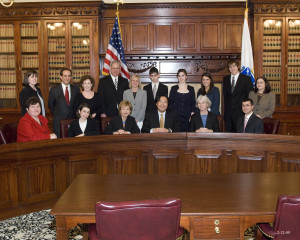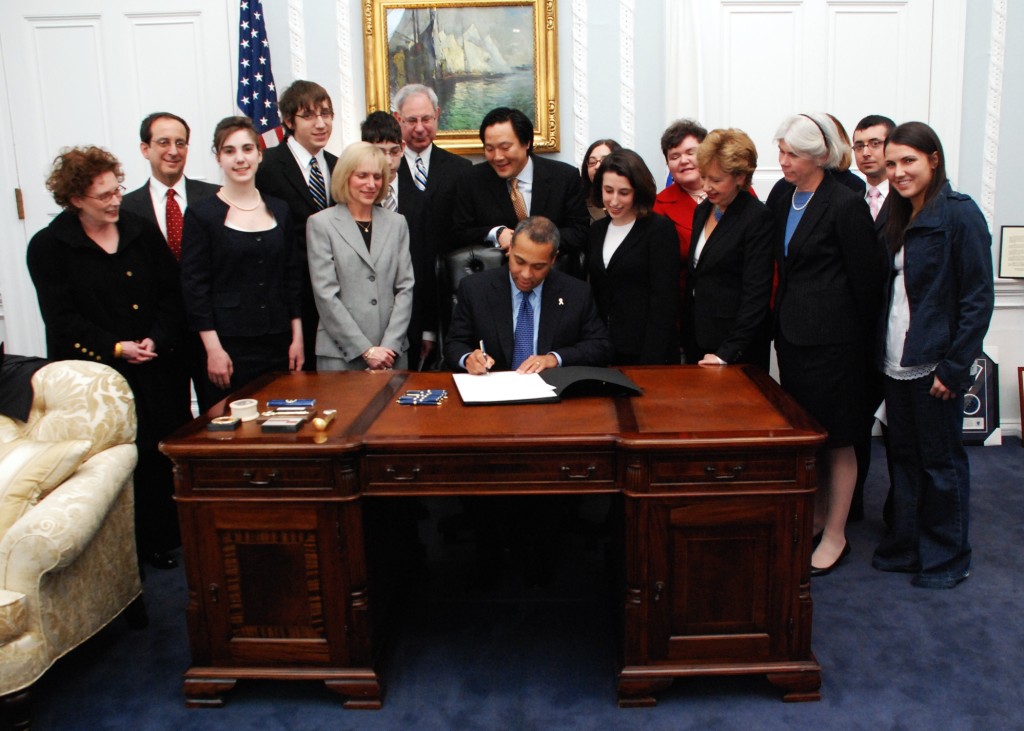AllergyHome proudly introduces our guest contributor, Chris Weiss. Chris is Director of Research and Dissemination for the Global Food Protection Institute (Battle Creek, Michigan), and formerly VP of Advocacy for the Food Allergy & Anaphylaxis Network (2001-2012). He has been a leader and trailblazer in food allergy advocacy for over a decade.Thank you Chris, for joining us.
Uncharted Territory for Food Allergy Awareness
When I started working with FAAN back in 2001, the restaurant world was largely uncharted territory when it came to food allergies. Although FAAN had developed a training guide and video for restaurants, these materials were rarely used. Remember, this was back when major allergens did not have to be listed, in plain language, on food labels. The entire landscape, however, began to change around 2003, when the labeling law started taking shape after years of collaboration among the Federal government, trade associations, the food industry, and FAAN.
Steps Forward for Food Allergy Awareness in Restaurants
Once the allergen labeling law was adopted in 2004, a number of restaurant-related dominos began to fall. In 2005, the FDA added food allergy-related provisions to its Food Code, which is a set of “best practices” guidelines for the retail and food service industry (restaurants, grocery stores, nursing homes, etc.). The Code, which is revised every couple of years, now recommends that the “person in charge” should be able to identify major food allergens, along with the symptoms of an allergic reaction, and should also ensure that employees are properly trained in food safety, including food allergy awareness, as it relates to their assigned duties.
Around the time of the 2005 Food Code, we started noticing that restaurant websites – typically the larger chain restaurants – were creating new pages devoted to allergens, which allowed families to identify menu items that were likely safe to eat. In fact, today, it is hard to find a large restaurant chain that does not have allergen information on their company website.
Champions of Food Allergy Awareness in Restaurants
But perhaps the most significant change in the landscape began to take shape in 2005 in the state of Massachusetts. A teenage girl named Julia Stern, frustrated with local restaurants not being able to accommodate her food allergy, reached out to her local state senator, Cynthia Creem (who, incidentally, is still a member of the state senate ).
 Senator Creem’s office reached out to FAAN and the Massachusetts Restaurant Association (MRA), and we began drafting a bill that the senator would introduce into the state legislature. The challenge with legislation is drafting language/provisions that all of the affected stakeholders can agree on. Also getting involved was celebrity chef Ming Tsai, who owns and operates his own restaurant near Boston, and who also has children with food allergy. Chef Tsai had, at the time, implemented a variety of allergen control measures at his restaurant, and his establishment was widely regarded as being “allergen-friendly”. Other advocates in Massachusetts, including Boston area allergist Dr. Michael Pistiner lobbied and rallied support for passage of this bill.
Senator Creem’s office reached out to FAAN and the Massachusetts Restaurant Association (MRA), and we began drafting a bill that the senator would introduce into the state legislature. The challenge with legislation is drafting language/provisions that all of the affected stakeholders can agree on. Also getting involved was celebrity chef Ming Tsai, who owns and operates his own restaurant near Boston, and who also has children with food allergy. Chef Tsai had, at the time, implemented a variety of allergen control measures at his restaurant, and his establishment was widely regarded as being “allergen-friendly”. Other advocates in Massachusetts, including Boston area allergist Dr. Michael Pistiner lobbied and rallied support for passage of this bill.
The 1st Food Allergy Awareness in Restaurants Law: Massachusetts Allergen Awareness Act
Ultimately (around 2009), a version of the bill was drafted that everyone seemed happy with. The bill was passed, and there was even a bill-signing ceremony held at the Governor’s office. A special working group was also formed by the state Department of Public Health to help with implementation.
As a result of this important legislative accomplishment, restaurants in Massachusetts must: 1) display a food allergy awareness poster in the staff/employee area; 2) add a notice on the menu (or menu board) alerting customers to inform the restaurant if anyone in their party has a food allergy; and 3) ensure that managers watch a food allergy awareness video on food allergies. The video was actually the same one created by FAAN around 2000, but was revised/updated for the purpose of the new law. Key contributors to the updated video included Chef Tsai, along with Dr. Pistiner who would later co-create a food allergy education website called Allergyhome.org.
Food Allergy Awareness in Restaurants is Spreading
Based on the success in Massachusetts, another state (Rhode Island) passed an almost identical bill in 2011, and other states can be expected to come on board in the near future.
Another significant change in the restaurant landscape occurred just recently, when the National Restaurant Association (NRA) created the ServSafe Allergens Online Training Course. The course is available on the NRA website, and can be taken by any restaurant employee in the nation.
There is also Allergy Eats, an online guide to food allergy-friendly restaurants. The website, created by Paul Antico, allows people to “rate” restaurants based on their dining experiences and can help folks find restaurants in their area that may (or may not) be able to accommodate food allergies.
Clearly, the restaurant landscape has improved immensely over the past decade. Today, consumers affected by food allergy can expect restaurants to have a certain level of awareness and understanding of food allergy. Of course, some restaurants may be unable to accommodate customers, which is why it is still important to do your homework. Calling ahead, visiting the restaurant, talking to senior staff, visiting the restaurant website, and asking your friends/peers are all excellent ways to find out if a particular restaurant is right for you. Even with increased awareness on the part of restaurants, patrons must continue to choose wisely and communicate effectively.
For tips on dining out with food allergies see: Dining Out With Food Allergies Can Be Safe and Fun
 Christopher Weiss, Ph.D., is Director of Research and Dissemination for the Global Food Protection Institute in Battle Creek, Michigan. He brings more than twelve years of experience working in the non-profit sector, eleven of which were spent with the Food Allergy & Anaphylaxis Network (FAAN, which is now FARE). He has worked with policymakers at the local, state, and national level, and helped author the Food Allergy and Anaphylaxis Management Act (FAAMA), which created national guidelines to help schools manage students with life-threatening food allergy, and the Food Allergen Labeling and Consumer Protection Act (FALCPA), which requires major food allergens to be declared on ingredient labels. Chris was also instrumental in enacting the Massachusetts Allergen Awareness Act, which makes restaurants in that state better equipped to manage customers with food allergy. Chris has been published in a variety of journals, and his most recent research (conducted for the Centers for Disease Control) addresses racial disparity among the food-allergic population in the US. Chris was born and raised outside of Boston, MA, and earned a doctoral degree from Florida State University.
Christopher Weiss, Ph.D., is Director of Research and Dissemination for the Global Food Protection Institute in Battle Creek, Michigan. He brings more than twelve years of experience working in the non-profit sector, eleven of which were spent with the Food Allergy & Anaphylaxis Network (FAAN, which is now FARE). He has worked with policymakers at the local, state, and national level, and helped author the Food Allergy and Anaphylaxis Management Act (FAAMA), which created national guidelines to help schools manage students with life-threatening food allergy, and the Food Allergen Labeling and Consumer Protection Act (FALCPA), which requires major food allergens to be declared on ingredient labels. Chris was also instrumental in enacting the Massachusetts Allergen Awareness Act, which makes restaurants in that state better equipped to manage customers with food allergy. Chris has been published in a variety of journals, and his most recent research (conducted for the Centers for Disease Control) addresses racial disparity among the food-allergic population in the US. Chris was born and raised outside of Boston, MA, and earned a doctoral degree from Florida State University.

So happy to hear about these improvements, but we still have a long way to go. Let me know how I can help.
http://wp.me/2fyoW
Once again, we are being inspired by Chris Weiss. Thank you for the well written background on how our food allergy world is progressing within the realm of restaurants.